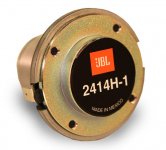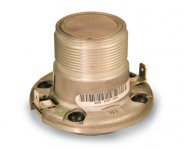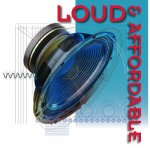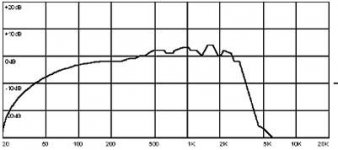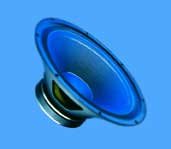I stand corrected!
Only found the speaker you mentioned and a 'sub-compact line array' but 2.2kHz is about twice as high as I would like to cross a 15".
If using a 90deg horn I'd cross at around 800Hz for an 18", 1000Hz for a 15" and 1200Hz for a 12" give or take a couple of 100Hz.
Might go a wee bit higher for horns with narrower dispersion.
Only found the speaker you mentioned and a 'sub-compact line array' but 2.2kHz is about twice as high as I would like to cross a 15".
If using a 90deg horn I'd cross at around 800Hz for an 18", 1000Hz for a 15" and 1200Hz for a 12" give or take a couple of 100Hz.
Might go a wee bit higher for horns with narrower dispersion.
PS: Somewhere I have heard that JBL licensed some compression drivers from BMS.
Don't know if true but if it is could the 2414 be one of them?
Don't know if true but if it is could the 2414 be one of them?
have you seen the 2414H measurements that I posted some pages ago?
This driver is difficult to filter and eq passively, and cannot be crossed lower than ~2khz, even on a big horn.
Hi pos
No I haven't seen your 2414H measurements, where are they ?
It seems that as the 2414H is only available for bespoke JBL products as a spare & is not generaly sold, there apears not to be a datasheet on it.
Not that I can find, any way. 😕
Do you have a 2414H data sheet ?
I would like to use X over @ 2K ish.
The JBL - AC26 installation speakers HF end useing this compression driver sound suuuuuuuperb.
Guide me to your measurements pos.
Cheers
Simon
Has anyone had any experience of using the Dayton Audio waveguides in any of their projects ?
Yes. And they sound just like they look.
Yes. And they sound just like they look.
They look a bit like sink plungers, do they sound blocked up ?
I had thought about knocking off the waveguide from the JBL installation speaker as the sound seemed so good.
The 90 x 90 disspertion pattern is to my ears good.
I find sometimes with horizontal patterns, particularly wide ones, that depending on the situation, it's hard to aim them without getting lots of bounce back reflections.
It's not easy for me to get Dayton stuff in the UK, but was interested because of the all round, not horizontal, disspertion.
Having studied the crossover of the AC26 installation speaker, I must say that JBL have scattered inductors around in there like confetti, and would like my crossover to be way more minimal than that !
Cheers
Simon
Those inductors are there for a reason:Having studied the crossover of the AC26 installation speaker, I must say that JBL have scattered inductors around in there like confetti, and would like my crossover to be way more minimal than that !
link: 2414h
thoses measurement are made on the same waveguide as the AC16/AC26 speaker.
you need to compensate for the driver rolloff (on a constant directivity horn at least) *and* apply some notch filters.
in comparison the 2407 is much easier to filter/eq, and can be used lower
They look a bit like sink plungers, do they sound blocked up ?
LOL! No, they sound quite open, actually. Open, shallow, regular. And you can really hear right down into the driver on axis. That's good or bad, depending on your tastes.
Check out some of the "Econowave" threads and posts. There are a number of great and inexpensive horns and waveguides out there.
Thanks pos
Hi pos
I totaly missed the tiny link on page 4.
Mmmmm...
Yes when I saw the AC26 cross over I was even keener to see some full data on the driver.
Also concerned about the size, after hearing Godzilla blew 2 of them.
Thanks very much for the measurements.
It really looks like trouble.
I did wonder, if they were that great & easy to use, why JBL only supply them as a spare, and provide no data.
You have solved the puzzle.
You said you used the waveguide from an AC16, was it 90 x 90 ? as I was under the impression the JBL part# for the AC16 waveguide is PT-B99HF-1.
The JBL CD is not as easy for me to get as the Celestion brand is, and the Celestion data on the CDX1-1745 indicates a 'normal' response, and weighing in at over 2Kg seems to have a bit of inbuilt cooling potential !
Cheers
Simon
P.S. It seems a bit strange that JBL should apparently manufacture the same component in two different locations (Mexico & the USA as indicated by the stickers on the body).
The photos of the CD here, came from a USA web site 'claiming' to be selling 'genuine' JBL parts.
I was unable to find any photos of the CD on the official JBL pro spares site.
Mmmmm.....
Those inductors are there for a reason:
link: 2414h
thoses measurement are made on the same waveguide as the AC16/AC26 speaker.
you need to compensate for the driver rolloff (on a constant directivity horn at least) *and* apply some notch filters.
in comparison the 2407 is much easier to filter/eq, and can be used lower
Hi pos
I totaly missed the tiny link on page 4.
Mmmmm...
Yes when I saw the AC26 cross over I was even keener to see some full data on the driver.
Also concerned about the size, after hearing Godzilla blew 2 of them.
Thanks very much for the measurements.
It really looks like trouble.
I did wonder, if they were that great & easy to use, why JBL only supply them as a spare, and provide no data.
You have solved the puzzle.
You said you used the waveguide from an AC16, was it 90 x 90 ? as I was under the impression the JBL part# for the AC16 waveguide is PT-B99HF-1.
The JBL CD is not as easy for me to get as the Celestion brand is, and the Celestion data on the CDX1-1745 indicates a 'normal' response, and weighing in at over 2Kg seems to have a bit of inbuilt cooling potential !
Cheers
Simon
P.S. It seems a bit strange that JBL should apparently manufacture the same component in two different locations (Mexico & the USA as indicated by the stickers on the body).
The photos of the CD here, came from a USA web site 'claiming' to be selling 'genuine' JBL parts.
I was unable to find any photos of the CD on the official JBL pro spares site.
Mmmmm.....
Attachments
Nothing JBL is manufactured in the US now, it is all mexico or china.
I doubt the 2414 or 2414-1 was ever produced in the US.
The 2407 is a BMS 4540nd, manufactured buy BMS without much modification.
The waveguide in the AC16 and AC26 is the PT-B99HF-1 indeed.
Maybe you should look for the bigger brother, the PT-F95
parts express sells two clones (and even better than the original thanks to the metal insert) under the brand dayton and pyle:
Dayton Audio H6512 6-1/2" x 12" Waveguide 1" Threaded
Pyle Pro PH612 1" Screw-On Constant Radiation Horn
They are similar to the PT-B99HF-1, only large (twice the dimension), and with a 90*50 pattern (albeit under 2 or 3khz the vertical pattern is much larger than that).
I doubt the 2414 or 2414-1 was ever produced in the US.
The 2407 is a BMS 4540nd, manufactured buy BMS without much modification.
The waveguide in the AC16 and AC26 is the PT-B99HF-1 indeed.
Maybe you should look for the bigger brother, the PT-F95
parts express sells two clones (and even better than the original thanks to the metal insert) under the brand dayton and pyle:
Dayton Audio H6512 6-1/2" x 12" Waveguide 1" Threaded
Pyle Pro PH612 1" Screw-On Constant Radiation Horn
They are similar to the PT-B99HF-1, only large (twice the dimension), and with a 90*50 pattern (albeit under 2 or 3khz the vertical pattern is much larger than that).
PS: Somewhere I have heard that JBL licensed some compression drivers from BMS.
Don't know if true but if it is could the 2414 be one of them?
Yes.
The JBL 2407H is the licensed version of BMS 4540ND
They are getting knocked out at £150 in the UK

Simon
Here's a brain teaser for all the number crunchers out there !
A friend of mine just sent me this on my cell phone !
This year will have four unusual dates:-
1/1/11
1/11/11
11/1/11
11/11/11
This year October will have:-
5 Saturdays
5 Sundays &
5 Mondays
Which only happens once every 823 years.
Birthdays seem to be a bit odd this year as well:-
Take the last 2 digits from the year you were born...
Now add to that your age...
And the answer to that will be the same for everyone:-
111
Mmmm...Simon
A friend of mine just sent me this on my cell phone !
This year will have four unusual dates:-
1/1/11
1/11/11
11/1/11
11/11/11
This year October will have:-
5 Saturdays
5 Sundays &
5 Mondays
Which only happens once every 823 years.
Birthdays seem to be a bit odd this year as well:-
Take the last 2 digits from the year you were born...
Now add to that your age...
And the answer to that will be the same for everyone:-
111
Mmmm...Simon
>>> Godzilla (as discussed a few posts back) has blown a couple of them though...
Every compression driver blows at the karate school... it's caused by the spike a mic produces if the volume is up and the mic is turned on. These tweeters go louder than just about all i've heard and do not pierce anyone's ears. I was very surprised to see how small they were... The EON is made so nothing else can fit into the cabinet but that little driver. Smart thinking JBL. They cost around $75 each here in the usa.
I thought the suggestion of using two 15" drivers was a good one... or maybe four 12"... tall and slim to fit into your doorway... loud as hell... and efficient as well. An 18" plus tweeter will result in a stocky box... why limit the design? If you want that 28hz then purchase the Eminence (surely a great and interesting driver) and econowave it using the round dayton... it will likely sound great.
Zilla
Every compression driver blows at the karate school... it's caused by the spike a mic produces if the volume is up and the mic is turned on. These tweeters go louder than just about all i've heard and do not pierce anyone's ears. I was very surprised to see how small they were... The EON is made so nothing else can fit into the cabinet but that little driver. Smart thinking JBL. They cost around $75 each here in the usa.
I thought the suggestion of using two 15" drivers was a good one... or maybe four 12"... tall and slim to fit into your doorway... loud as hell... and efficient as well. An 18" plus tweeter will result in a stocky box... why limit the design? If you want that 28hz then purchase the Eminence (surely a great and interesting driver) and econowave it using the round dayton... it will likely sound great.
Zilla
'The Versatile' - 18" Driver Update - Design Considerations - Part 1
Although the Eminence Sigma Pro 18A-2 seems to tick all the right boxes (at least on paper).
It would be nice to find some credible alternatives to consider.
Obviously there are 'dozens' of manufacturers, making 'dozens' of 18" drivers.
Power handling, to me at least, is not an issue for 'the versatile' loudspeaker.
If I am able to feed the speaker 100 Watts of good clean power, I will be a happy bunny.
This means any guitar or bass amp, any 'Hi-Fi' tube amp or SS amp, and the vast majority of studio monitor & PA amps commonly in use would all be usable.
Indeed the lowest published spec. for 18" power handling I can find is 300 Watts.
Power handling considerations in fact, ensure that 95% of the available 18" drivers out there, can be rejected straight away with little further thought.
Why..?
(Part 2 to follow...Can't believe I'm doing this on 'Cell Phone Internet'!)
Simon
Although the Eminence Sigma Pro 18A-2 seems to tick all the right boxes (at least on paper).
It would be nice to find some credible alternatives to consider.
Obviously there are 'dozens' of manufacturers, making 'dozens' of 18" drivers.
Power handling, to me at least, is not an issue for 'the versatile' loudspeaker.
If I am able to feed the speaker 100 Watts of good clean power, I will be a happy bunny.
This means any guitar or bass amp, any 'Hi-Fi' tube amp or SS amp, and the vast majority of studio monitor & PA amps commonly in use would all be usable.
Indeed the lowest published spec. for 18" power handling I can find is 300 Watts.
Power handling considerations in fact, ensure that 95% of the available 18" drivers out there, can be rejected straight away with little further thought.
Why..?
(Part 2 to follow...Can't believe I'm doing this on 'Cell Phone Internet'!)
Simon
'The Versatile' - 18" Driver Update - Design Considerations - Part 2
...Back again
I'm trying to write this like something which would have been useful to myself back in the early 80's when I made my first speakers.
Back then there was no internet, I knew no one who built speakers, and my only source of information was my local public library, where there seemed to be 2 types of book available;
1. Ready made plan books, which tell you exactly how and what to do to make a speaker, but not WHY to do these things.
&
2. The other type of book was the loudspeaker scientific textbook, which told you why to do everything, but not HOW to do it.
But nothing in the middle ground, where never the twain did meet !
To me generalisations (properly made) are useful, as they help to whittle down the huge myriad of options possible to solve any problem.
Once the generalisations have been made, whittle them down to come up with the specifics of the solution.
And then keep your fingures crossed and hope for the best !
My other thought is that it's good to have an emergency exit or escape route standing by.
I always hope my plane isn't going to fail and crash, but a parachute is even more reasuring before taking off.
eg.
I have a very bad habit, due to the need for 'space', of trying to fit too much electronics into too smaller box (it hasn't caught me out yet, but it might just have with the PSU box for my new valve mic !...Mmmm...).
An obvious thought perhaps, but, a speaker cabinet that is too large, can often be cut down to make it smaller. The reverse is slightly more problematic.
Not ideal maybe, but a good escape route to avoid burning all that timber !
I hope that explains a few of my thoughts about the project.
And allows me to 'get away' with a few of the inevitable generalisations to come !
Slightly diverted...Mmmm...maybe...
Anyway...
Back to driver choice next.
Simon
...Back again
I'm trying to write this like something which would have been useful to myself back in the early 80's when I made my first speakers.
Back then there was no internet, I knew no one who built speakers, and my only source of information was my local public library, where there seemed to be 2 types of book available;
1. Ready made plan books, which tell you exactly how and what to do to make a speaker, but not WHY to do these things.
&
2. The other type of book was the loudspeaker scientific textbook, which told you why to do everything, but not HOW to do it.
But nothing in the middle ground, where never the twain did meet !
To me generalisations (properly made) are useful, as they help to whittle down the huge myriad of options possible to solve any problem.
Once the generalisations have been made, whittle them down to come up with the specifics of the solution.
And then keep your fingures crossed and hope for the best !
My other thought is that it's good to have an emergency exit or escape route standing by.
I always hope my plane isn't going to fail and crash, but a parachute is even more reasuring before taking off.
eg.
I have a very bad habit, due to the need for 'space', of trying to fit too much electronics into too smaller box (it hasn't caught me out yet, but it might just have with the PSU box for my new valve mic !...Mmmm...).
An obvious thought perhaps, but, a speaker cabinet that is too large, can often be cut down to make it smaller. The reverse is slightly more problematic.
Not ideal maybe, but a good escape route to avoid burning all that timber !
I hope that explains a few of my thoughts about the project.
And allows me to 'get away' with a few of the inevitable generalisations to come !
Slightly diverted...Mmmm...maybe...
Anyway...
Back to driver choice next.
Simon
Last edited:
'The Versatile' - 18" Driver Update - Design Considerations - Part 3
.....Why can 95% of all the 18" drivers made, be rejected without further thought, for 'the versatile' loudspeaker application ?
Quite simply...'Moving Mass'
Moving Mass is a product of 3 things:-
1. The airload on the cone (if you wanted to play the speaker at the top of Mt. Everest, the airload would be less, but you might have a job getting it up there).
...and two constants...
2. The mass of the cone.
&
3. The mass of the voice coil.
95% of 18" drivers made are intended for VERY HIGH POWER applications, such as huge club bass bins & horns for example.
The mass of the cone, I would imagine, for most 18" drivers is very similar, all those I have seen are always made out of paper (if anyone knows of an alloy or other cone material 18" driver, let me know, I would be interested to check it out).
The mass of the voice coil however, obviously goes up proportionaly, along with the power handling.
Some companys use alloy voice coils, in an effort to reduce voice coil mass and overall moving mass.
I would however prefer 'the versatile' loudspeaker to have a copper voice coil.
Here's an example from the Eminence range of pro-audio drivers.
In this example, even a small rise in power handling, results in an almost doubling of Moving Mass:-
Sigma Pro 18A-2 650 Watts RMS Mms 130 grams V.coil 3" dia
Definimax 4018L 800 Watts RMS Mms 211 grams V.coil 4" dia
Both drivers have a similar magnet weight, and overall weight of 11 Kg
The laws of diminishing returns set in very quickly here indeed. If you want even greater power handling, the figures are exponentialy worse.
Also frequency response tends to drop rapidly along with higher power handling + higher Moving Mass, and the cost of such drivers spirals upward.
eg.
Sigma Pro 18A-2, 2.4K Hz, Sens 99 dB Definimax 4018L, 200 Hz, Sens 95 dB
It's also interesting to note in this example, that the Sigma Pro is a way more efficient driver by a significant factor of 4 dB.
Thats all well and good if you want to build a bass bin big enough for a dozen people to dance on top of.
But no use at all for less power demanding applications, such as home audio, Hi-Fi, guitar or portable PA. Where the advantages and not the drawbacks of an 18" driver are required.
I know we tend to think the more money we pay for something the better it must be.
But as a rule of thumb in this application, the more you think of spending on a pro audio 18" driver, the worse driver you will get !
Nuf said about Moving Mass I think...
...Later...
Simon
.....Why can 95% of all the 18" drivers made, be rejected without further thought, for 'the versatile' loudspeaker application ?
Quite simply...'Moving Mass'
Moving Mass is a product of 3 things:-
1. The airload on the cone (if you wanted to play the speaker at the top of Mt. Everest, the airload would be less, but you might have a job getting it up there).
...and two constants...
2. The mass of the cone.
&
3. The mass of the voice coil.
95% of 18" drivers made are intended for VERY HIGH POWER applications, such as huge club bass bins & horns for example.
The mass of the cone, I would imagine, for most 18" drivers is very similar, all those I have seen are always made out of paper (if anyone knows of an alloy or other cone material 18" driver, let me know, I would be interested to check it out).
The mass of the voice coil however, obviously goes up proportionaly, along with the power handling.
Some companys use alloy voice coils, in an effort to reduce voice coil mass and overall moving mass.
I would however prefer 'the versatile' loudspeaker to have a copper voice coil.
Here's an example from the Eminence range of pro-audio drivers.
In this example, even a small rise in power handling, results in an almost doubling of Moving Mass:-
Sigma Pro 18A-2 650 Watts RMS Mms 130 grams V.coil 3" dia
Definimax 4018L 800 Watts RMS Mms 211 grams V.coil 4" dia
Both drivers have a similar magnet weight, and overall weight of 11 Kg
The laws of diminishing returns set in very quickly here indeed. If you want even greater power handling, the figures are exponentialy worse.
Also frequency response tends to drop rapidly along with higher power handling + higher Moving Mass, and the cost of such drivers spirals upward.
eg.
Sigma Pro 18A-2, 2.4K Hz, Sens 99 dB Definimax 4018L, 200 Hz, Sens 95 dB
It's also interesting to note in this example, that the Sigma Pro is a way more efficient driver by a significant factor of 4 dB.
Thats all well and good if you want to build a bass bin big enough for a dozen people to dance on top of.
But no use at all for less power demanding applications, such as home audio, Hi-Fi, guitar or portable PA. Where the advantages and not the drawbacks of an 18" driver are required.
I know we tend to think the more money we pay for something the better it must be.
But as a rule of thumb in this application, the more you think of spending on a pro audio 18" driver, the worse driver you will get !
Nuf said about Moving Mass I think...
...Later...
Simon
Precision Devices PD 2150 Driver
Hi Godzilla
Good question, what size ? indeed. Mmmm..?
I did do something as silly as my bad sense of humour today.
I spent a bit of time looking at the Precision Devices PD 2150 - 21"... 😱
As Samuel L. Jackson said in Quentin's Oscar award winning 'Pulp Fiction' :-
"It's the one with bad a** muther f***er written on it"
Interesting...VVeerryy interesting... Mmmm...
The law of diminishing returns def. applies to this little baby.
However...
It's moving mass is high at 305 grams (but does have a V8 motor to drive it).
It's resonance is VERY low at 22 Hz
It's response extends to 1K Hz
Sensitivity is good at 99 dB
& has an absolutely HUGE cone area of 1630 cm Sq...!
Disadvantages are (the weight doesn't bother me personaly, but I'll quote it any way) :-
34 Kg / 75 lb total weight
Not easily available outside Europe (no distribution in North America, & other places, special import only).
Although fairly good frequency extension for such a monster,
it would either mean designing a 3 way speaker (which we don't want).
or, using a compression driver that decently reaches down to 1K with a little bit of power handleing (which could be fairly expensive).
also crossover components would be a bit more costly (but we won't split hairs about that).
Obviously more wood & bigger box as well.
I didn't even bother enquiring about price, I was feeling a little bit nauseous already.
Mmmm...😱
Simon
P.S - also the thread would have to be renamed.
Neat stuff simon... question, what would you like the size of your speaker to be?
Hi Godzilla
Good question, what size ? indeed. Mmmm..?
I did do something as silly as my bad sense of humour today.
I spent a bit of time looking at the Precision Devices PD 2150 - 21"... 😱
As Samuel L. Jackson said in Quentin's Oscar award winning 'Pulp Fiction' :-
"It's the one with bad a** muther f***er written on it"
Interesting...VVeerryy interesting... Mmmm...
The law of diminishing returns def. applies to this little baby.
However...
It's moving mass is high at 305 grams (but does have a V8 motor to drive it).
It's resonance is VERY low at 22 Hz
It's response extends to 1K Hz
Sensitivity is good at 99 dB
& has an absolutely HUGE cone area of 1630 cm Sq...!
Disadvantages are (the weight doesn't bother me personaly, but I'll quote it any way) :-
34 Kg / 75 lb total weight
Not easily available outside Europe (no distribution in North America, & other places, special import only).
Although fairly good frequency extension for such a monster,
it would either mean designing a 3 way speaker (which we don't want).
or, using a compression driver that decently reaches down to 1K with a little bit of power handleing (which could be fairly expensive).
also crossover components would be a bit more costly (but we won't split hairs about that).
Obviously more wood & bigger box as well.
I didn't even bother enquiring about price, I was feeling a little bit nauseous already.
Mmmm...😱

Simon
P.S - also the thread would have to be renamed.
'Volt Loudspeakers' - England
Hi CD
Went back to look at Volt again.
There is a non full battle tank volt 18"
a sort of Volt armoured car.
Less bulk, and nimble, but still packs a punch.
It's the Volt PS18/300
They also do a dual coil version called the PS18/300 DC
Here's some numbers:-
Freq 25 Hz - 2.5K Hz
Reso 31 Hz (bit high...sigh...)
Mms 176 grams
Magnet 8 Kg
Total weight 10 Kg
Power 300 Watts
Voice coil 3"
Chassis - Pressed steel
Max excursion before dammage - 25 mm !!! 😱
Volt quote -3 dB @ 35 Hz in a 200 Litre bass reflex enclosure.
Didn't get a price, as Volt are professional recluses, and don't like speaking on the phone.
Too busy winding coils & shifting large magnets about I guess.
Cheers
Simon
If you like large magnets how about a Volt
they are built in the UK to order.
Volt Loudspeakers - About Us
Hi CD
Went back to look at Volt again.
There is a non full battle tank volt 18"
a sort of Volt armoured car.
Less bulk, and nimble, but still packs a punch.
It's the Volt PS18/300
They also do a dual coil version called the PS18/300 DC
Here's some numbers:-
Freq 25 Hz - 2.5K Hz

Reso 31 Hz (bit high...sigh...)
Mms 176 grams
Magnet 8 Kg
Total weight 10 Kg
Power 300 Watts
Voice coil 3"
Chassis - Pressed steel
Max excursion before dammage - 25 mm !!! 😱
Volt quote -3 dB @ 35 Hz in a 200 Litre bass reflex enclosure.
Didn't get a price, as Volt are professional recluses, and don't like speaking on the phone.
Too busy winding coils & shifting large magnets about I guess.
Cheers
Simon
- Status
- Not open for further replies.
- Home
- Loudspeakers
- Multi-Way
- 18" + WAVEGUIDE - 2 Way Bass Reflex 'THE VERSATILE' Loudspeaker.
